 |
JAMES BOND
|
 |
JAMES BOND
|
|
||
|
|
With the James Bond series unable to continue production as a result of legal complications throughout the first half of the 1990s, this period saw the rise of fandom on both sides of the Atlantic. A groundbreaking convention held at Pinewood Studios in September 1990 produced by 007 MAGAZINE Editor & Publisher Graham Rye, featured the largest collection of James Bond props ever assembled. Special screenings of several James Bond films at London's National Film Theatre throughout the decade also kept 007 alive for British audiences. There was still huge interest in the series which continued to be screened on ITV television in the UK, and re-released on video in special collectors’ editions. Another historic event produced by Graham Rye - The 1994 James Bond 007 Fan Club Christmas Lunch, held again at Pinewood Studios, was the first UK autograph signing ever undertaken by one-time James Bond George Lazenby. Other celebrity guests included Lois Maxwell and Desmond Llewelyn, reunited with Lazenby for the first time since the release of On Her Majesty's Secret Service in 1969. As James Bond fandom grew and was kept alive via 007 MAGAZINE, the world waited to see if the film series would return, and if it did, who would play Ian Fleming's secret agent? |
|||
|
|||
|
During the six-year hiatus whilst James Bond was absent from cinema screens, the industry had seen a huge shift in the development of special effects. The rise in use of computer generated imagery in the early 1990s, saw the gradual demise of practical effects in big budget films. When 007 returned to the big screen in GoldenEye (1995) the first image seen in the film was a new computer generated gun barrel sequence designed by Daniel Kleinman, and based on Maurice Binder's 1962 iconic motif. Following Binder's death in 1991, Kleinman also designed the main titles for all remaining films in the series with the exception of Quantum of Solace (2008). All of his main title sequences have been largely aided by computer generated images and effects. By contrast the majority of special effects in GoldenEye were photographed using miniatures and scale models designed by Derek Meddings, whose sixth and final James Bond film this would be. Meddings died on September 10, 1995 during post-production of the 17th 007 adventure. GoldenEye is dedicated to his memory. |
|||
|
|
|||
|
Derek Meddings began his career working as an assistant to special effects pioneer Les Bowie (1913-1979), before beginning a successful period working on several “Supermarionation” puppet series produced by Gerry Anderson. Meddings was credited with the special effects for Anderson's 1960 series Supercar and Fireball XL5 (1962), then becoming special effects director for Stingray (1964). Meddings graduated to special effects supervisor for Thunderbirds (1965–66), during which time he was also responsible for the design of the Thunderbird machines themselves. He was visual effects supervisor for all the Anderson puppet series of the late 1960s (Captain Scarlet and the Mysterons, Joe 90 and The Secret Service) and also Anderson's first live-action series, UFO, at the start of the 1970s. He performed the same role on Anderson's three 1960s feature films, Thunderbirds Are Go (1966), Thunderbird 6 (1968) and the live-action Doppelgänger (1969) [also known as Journey to the Far Side of the Sun]. During his time working on these series, Meddings and his team developed a number of innovations in the filming of miniature models and landscapes, which then became standard in the industry before the rise of CGI. Joining the James Bond series for Live And Let Die in 1973, Meddings created several very realistic miniatures (including the destruction of Kananga's poppy fields) in a film with relatively few special effects sequences compared with earlier Bond adventures. This was followed by several more cost-saving miniatures for the climax of The Man With The Golden Gun (1974). |
|||
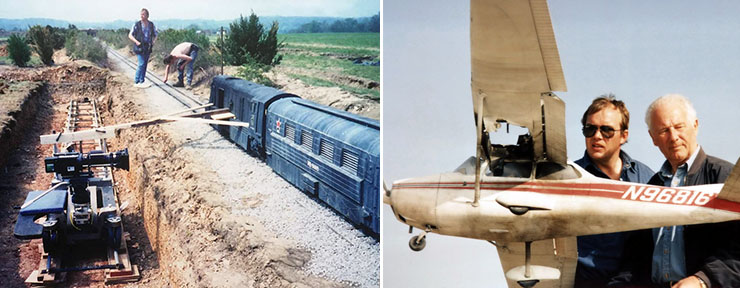 |
|||
|
Derek Meddings returned
to the series in 1977 with The Spy Who Loved Me, spending four
months on location in The Bahamas, where he supervised the construction of
a ‘miniature’ Liparus supertanker [actually more than 60ft (18m) long],
and three ‘miniature’ nuclear submarines for exterior sequences filmed at
sea. He also designed and built James Bond's Lotus Esprit which converted
into a submersible, cleverly intercutting full-sized body shells with
one-quarter-scale miniatures. |
|||
|
|||
|
Meddings again created several miniatures for GoldenEye (1995), including the crash of Alec Treveleyan's armoured train, and the jet fighter crash - with the whole sequence filmed on a scale model of the Russian space weapons control facility complex at Severnaya. For the climactic destruction of a gigantic satellite dish filmed partly at Arecibo Observatory in Puerto Rico, a model built by Meddings’ team was intercut with scenes shot with stuntmen in Britain. Meddings also supervised the model shots of Bond's Cessna crashing in the Cuban jungle. Derek Meddings also worked on Superman II (1980) and Superman III (1983), later serving as visual effects supervisor on Tim Burton's Batman (1989), and Cape Fear (1991) directed by Martin Scorsese. GoldenEye (1995) was the last James Bond film to rely solely on miniatures, with later entries utilising a combination of scale-models and computer enhanced effects, combined with practical action where possible. |
|||
|
|||
|
|||
|
James Bond's naval rank of Commander is mentioned several times throughout Ian Fleming's novels starting with MOONRAKER (1955). Ian Fleming's Bond had served in the Special Branch of the Royal Naval Volunteer Reserve during WWII, and risen to the senior rank of Commander, and therefore immediately junior to Captain. The R.N.V.R. cased to exist after 1958 when it was absorbed into the Royal Naval Reserve. Affectionately known as the ‘Wavy Navy’ on account of the rank identification insignia on officers sleeves being wavy rather than straight. In the novel THUNDERBALL (1961) James Bond refers to himself as a ‘Chocolate Sailor’ - a Royal Navy officer who's never, or rarely been to sea, someone working a bureaucratic job behind a desk in Whitehall rather than having a background as a serving sailor. Ian Fleming himself had also been described as a ‘Chocolate Sailor’ during his time in the Admiralty where he served in Naval Intelligence, and he shared a similar background to his literary creation. Although Fleming was demobilised in May 1945, he remained on the R.N.V.R. active list for several years, receiving a promotion to substantive Lieutenant-Commander (Special Branch) [a junior officer, one rank below that of Commander] on July 26, 1947. Ian Fleming ended his Naval service on August 16, 1952, after which he drew upon his Wartime experience to add a sense of authenticity to his James Bond novels. Charles Dance played Ian Fleming in the 1989 TV-Movie Goldeneye, and was seen wearing the correct R.N.V.R. uniform, with the insignia of Lieutenant-Commander on the sleeve. |
|||
|
|||
|
All six actors to play James Bond on screen in the EON Productions series have been referred to as ‘Commander’, but only three were actually seen in uniform - although their sleeves all bear the Royal Navy rank insignia, rather than the R.N.V.R. wavy stripes. It was not until You Only Live Twice (1967) that James Bond was seen in Naval uniform, firstly in a newspaper photograph announcing his ‘death’, and later as Sean Connery emerges from his shroud after being taken onboard a submarine where he meets M. George Lazenby's Bond is greeted as ‘Commander’ as he arrives at the Hotel Palacio in Estoril, and similarly addressed by Hammond (John Gay) as he visits M's Thames-side home ‘Quarterdeck’ in On Her Majesty's Secret Service (1969). Sean Connery's Bond was once again introduced as ‘Commander’ by M (Bernard Lee) as he meets Sir Donald Munger (Laurence Naismith) in Diamonds Are Forever (1971). Roger Moore was then seen in uniform as he arrives by helicopter at RAF Faslane in The Spy Who Loved Me (1977). Bond is introduced as ‘Commander Bond’ by Captain Benson (George Baker) to Frederick Gray, Minister of Defence (Geoffrey Keen) and Admiral Hargreaves (Robert Brown), where the latter refers to Bond as having served on HMS Ark Royal. Bond is shown wearing a uniform with the straight stripes on his sleeve befitting a full Naval Commander. Although Timothy Dalton's Bond had been referred to as Commander in Licence To Kill (1989) - once again by Robert Brown, this time playing M, it would be another 20 years before 007 was once again seen on screen in Naval Uniform. It would be Pierce Brosnan in Tomorrow Never Dies (1997) who was next seen in full Naval attire, marking the final time Ian Fleming's character wore the uniform as part of the storyline. Pierce Brosnan is seen in uniform with the rank of Commander when reunited with CIA Agent Jack Wade (Joe Don Baker) as he arrives at a U.S. Naval Base in the South China Sea. Proceeds from the World Charity Premiere of Tomorrow Never Dies (1997) were donated to the King George's Fund for Sailors. |
|||
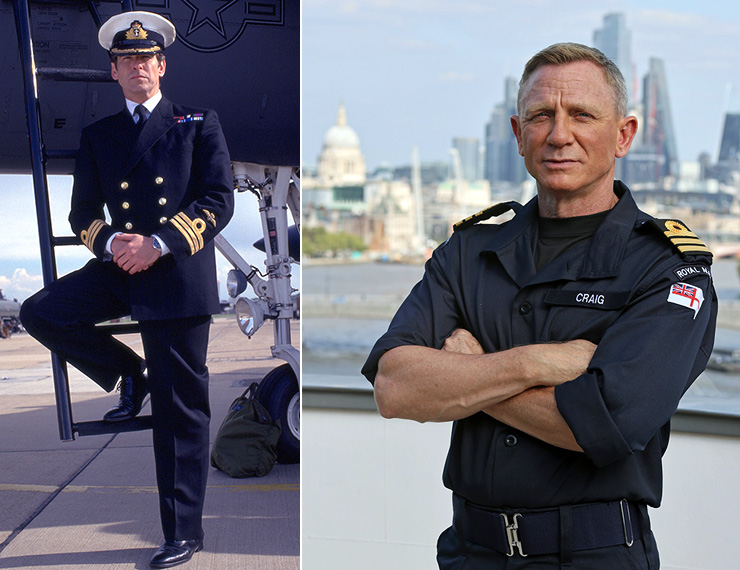 |
|||
|
In No Time To Die (2021) the new ‘007’ Agent Nomi (Lashana Lynch) refers to Daniel Craig's Bond as ‘Commander’ as she tries to encourage him to return to active service. Just before the release of the 25th James Bond film Daniel Craig was made an honorary Commander in the Royal Navy. Daniel Craig’s appointment as an honorary officer reflected his personal support for HM Armed Forces and links it with the legacy created through the guise of fictional British secret agent James Bond. Craig was photographed wearing a Royal Navy shirt [pictured above right] bearing the three striped shoulder epaulettes signifying the rank of Commander. In January 2022 it was announced that Daniel Craig would be recognised by Her Majesty Queen Elizabeth II, in the New Year's Honours List and awarded the C.M.G. (Companion of the Order of St. Michael and St. George), usually given to senior diplomats and spies. The C.M.G. is the same honour received by James Bond in Ian Fleming's novels. In FROM RUSSIA, WITH LOVE (1957) it is revealed via a Russian dossier that Bond was awarded the C.M.G. in 1953. Following the death of HM Queen Elizabeth II, Daniel Craig was later decorated by The Princess Royal at an investiture ceremony held at Windsor Castle on October 18, 2022. |
|||
|
|||
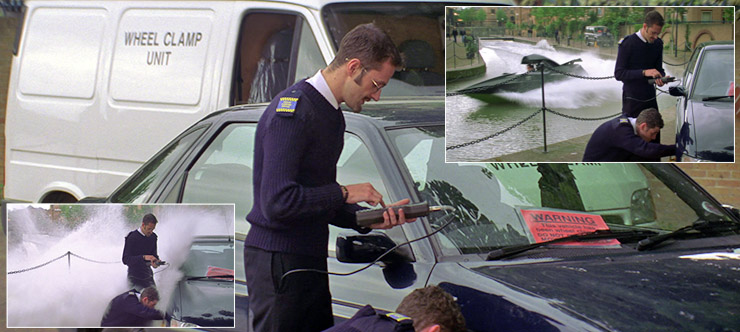 |
|||
|
Many of the ‘in-jokes’ and pop culture references in the James Bond films are now long-forgotten, and only still meaningful to audience members of a certain age. None more so than the inclusion of two traffic wardens from the then-current reality show The Clampers (BBC-TV 1998-99) during the lengthy pre-credit sequence of The World Is Not Enough (1999). The more prominent of the two clampers was supervisor Ray Brown, who along with his colleague are drenched by Pierce Brosnan in the speeding ‘Q Boat’. Whilst the characters may well have been recognised by British cinemagoers at the time of the films release, the passing years have reduced the short sequence to nothing more than just another ‘humorous’ aside that is lost on modern audiences. Similarly Roger Moore's James Bond speaking the line “Ever heard of Evel Knievel?” before barrel-rolling his car across a Thai canal in The Man With The Golden Gun (1974), is also a reference to a long dead real-life stunt performer that will probably not resonate with modern audiences. The appearance of Janet Brown and John Wells as Margaret and Denis Thatcher [pictured below] at the end of For Your Eyes Only (1981) roots the film in its contemporary setting, and the inclusion of the current British Prime Minister and her husband (played by then popular comedy performers) now also dates the film. |
|||
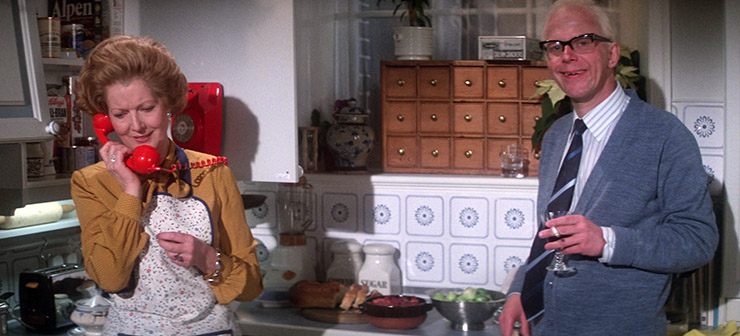 |
|||
|
Happily some verbal jokes are still relevant today - such as Sean Connery's Bond commenting that drinking Dom Perignon '53 below a temperature of 38° Fahrenheit in Goldfinger (1964), was as bad as “Listening to The Beatles without earmuffs!”. Back in 1964 there was no way the production team could have predicted that both James Bond and The Beatles would still be relevant 60 years later. |
|||
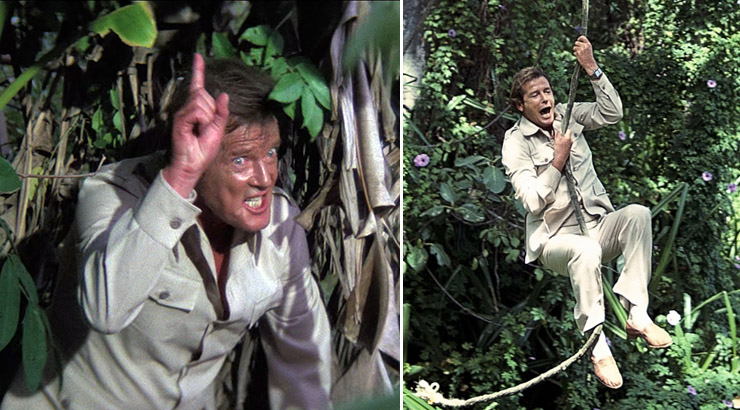 |
|||
|
The same cannot be said of some of the other verbal ‘in-jokes’ in the series. In Octopussy (1983) Roger Moore's Bond calls out “Sit!” to a tiger as it emerges from the undergrowth as he is pursued by Kamal Khan's (Louis Jourdan) men through the Indian jungle. This joke was a take-off of the catchphrase of the well-known British dog trainer Barbara Woodhouse (1910-1988), who would be relatively unknown outside the UK. In Germany the line was redubbed to “You belong in the tank” - which related to the more widely-known tag-line for ESSO gasoline - ‘Put a tiger in your tank’. Bond's incongruous Tarzan call in the same sequence in Octopussy (1983) could also fall into this category, as possibly a more well-known pop culture reference when the film was released than it is today. The whole sequence represents perhaps the low-point in the whole Roger Moore era, where the character is reduced to a series of clichés from dozens of jungle chase movies of old, with spiders, snakes (“Hiss off!”), and the obligatory leeches thrown into the mix - in the vain hope that one of them will prove amusing... |
|||
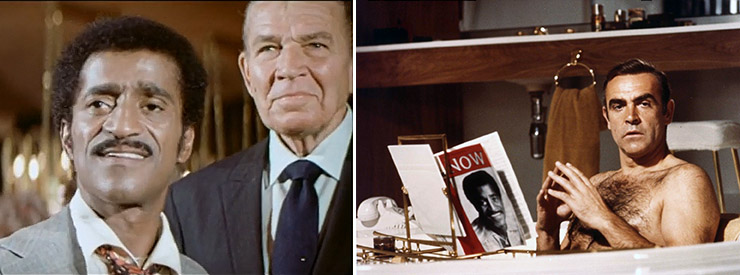 |
|||
|
Throughout the series there have also been cameo appearances by real-life performers playing fictional characters in the films. In Diamonds Are Forever (1971) American stand-up comedian Leonard Barr (1933-1980) played Shady Tree, one of the acts appearing at ‘The Whyte House’. Willard Whyte himself was also played by real-life American country music singer, television host, actor and businessman Jimmy Dean (1928-2010). In real life Leonard Barr was also the uncle of popular American singer, actor and comedian Dean Martin (1917-1995). Martin's fellow ‘Rat-Pack’ member Sammy Davis Jr. (1925-1990) also filmed a short cameo [pictured above left] as himself for Diamonds Are Forever (1971) as he speaks with Burt Saxby (Bruce Cabot) at the roulette table, but his scene was ultimately (and wisely) deleted. Sammy Davis Jr. is still present in the film however, with his face briefly seen on the cover and inside pages of Now magazine (above right) visible as James Bond (Sean Connery) takes a bath whilst speaking with Felix Leiter (Norman Burton) on the telephone upon his arrival in Las Vegas. |
|||
|
|
|||
|
Real-life sportsmen have also featured prominently in acting roles, but like many other pop-culture crossovers, their inclusion is somewhat diminished with the passing of time. Professional world class tennis player Vijay Amritraj (1953- ) was cast as MI6 intelligence operative Vijay in Octopussy (1983) and served as the films so-called ‘sacrificial lamb’ - a term coined by writer John Brosnan in his seminal 1972 book The James Bond Films - as one of those characters who are killed as a consequence of helping James Bond on his mission. Amritraj also had the dual indignity of being introduced as a snake charmer playing ‘The James Bond Theme’ to the wrong cobra as he meets James Bond (Roger Moore) in India! Amritraj also appeared in a screen test with American actor James Brolin (above top left), who was auditioning for the role of 007 before Roger Moore finally signed a contract to play Bond for a fifth time in Octopussy. Producer Albert R. Broccoli cast Vijay Amritraj in Octopussy after watching him play at Wimbledon. British show jumper Oliver Skeete (1956- ) had an incongruous minor role in Die Another Day (2002), as a concierge at at Blades club (above bottom left) where he gives Bond (Pierce Brosnan) the key to the London Underground offices of MI6. In the next film in the series Casino Royale (2006), Paris-born Sébastien Foucan (1974- ) founder of freerunning and considered an early developer of the athletic discipline of parkour, plays the significant role of Mollaka (above right), the terrorist pursued and ultimately killed by James Bond (Daniel Craig). |
|
||||||
|
2002 marked the 40th anniversary of James Bond in the cinema. Die Another Day, the 20th film of the series, went to extraordinary lengths to pack in as many references to the preceding adventures as possible, with numerous ‘in-jokes’ and homages to the literary and cinematic world of James Bond. For the scene set in Havana where Bond meets Raoul [played by Mexican actor Emilio Echevarria (1944-2025)] eagle-eyed viewers can spot Pierce Brosnan pick up the book Birds Of The West Indies, in a none-too-subtle nod to the volume by American ornithologist James Bond (1900-1989), whose name Ian Fleming had appropriated for his secret agent hero in 1953. Toby Stephens as Sir Gustav Graves makes his entrance into the film on a parachute sporting the Union Jack – in an obvious nod to Roger Moore’s James Bond in the pre-credit sequence of The Spy Who Loved Me (1977). The scene in Die Another Day is intercut with James Bond flying back to London accompanied by ‘London Calling!’ performed by The Clash on the soundtrack. As Bond is served a vodka martini by an air stewardess played by none other than Roger Moore’s daughter Deborah [pictured below right], he reads a British Airways High Life magazine featuring an interview with Gustav Graves (by Gregg Wilson – son of co-producer Michael G. Wilson) with the words ‘Diamonds Are Forever’ clearly visible on the page! |
||||||
 |
||||||
|
Sir Gustav Graves is later revealed to be Colonel Moon (who Bond thought he had killed in the pre-credit sequence set in North Korea), who has undergone gene therapy in order to change his identity. Colonel Moon is clearly a none-too-subtle take on the name of the title character from COLONEL SUN (1968) written by Kingsley Amis under the pseudonym Robert Markham. COLONEL SUN was the first James Bond novel written by another author after the death of Ian Fleming in 1964. The literary series would not resume until John Gardner took over writing duties in 1981 with LICENCE RENEWED. Die Another Day also features Blades club as the setting for the sword fight between Graves and Bond. The Reform Club on London's Pall Mall stood in for the interiors of Blades - a reference to the fictional gentleman's club frequented by M which first appeared in Ian Fleming's MOONRAKER (1955). |
||||||
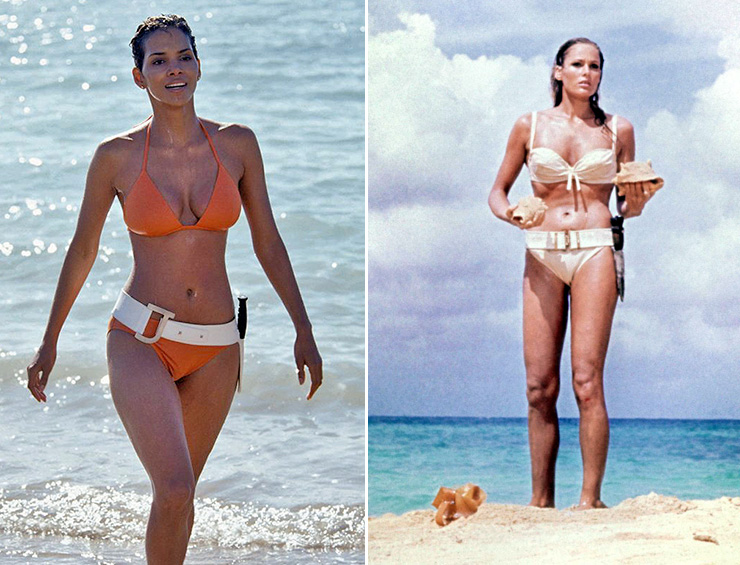 |
||||||
|
The most obvious on-screen reference to an earlier James Bond film is Halle Berry's appearance from the sea in Havana (filmed in Cadiz, Spain), which is a direct homage to the iconic debut of Ursula Andress as Honey Ryder in Dr. No (1962). Although Honey has a divers knife on her bikini belt for practical purposes, its appearance on Halle Berry is only there to give a clue as to the origin of the scene, as if there was any doubt in the mind of the audience! |
||||||
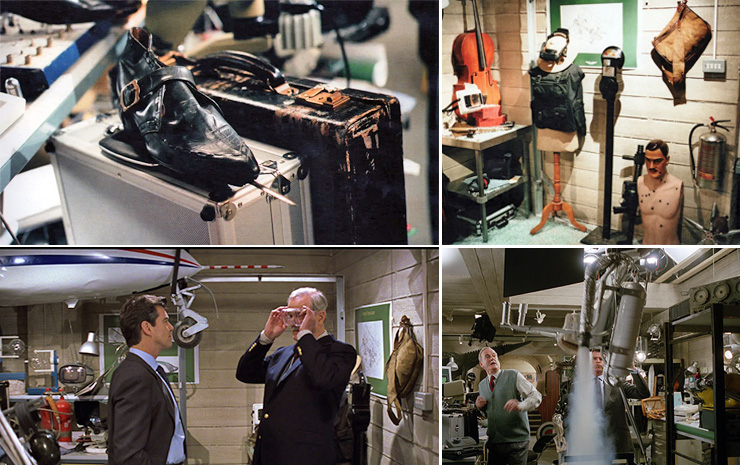 |
||||||
|
The scene in Q’s underground laboratory is filled with all manner of gadgets and props from earlier films, allowing Pierce Brosnan to indulge in some none-too-funny business and inept quips at the expense of the new Quartermaster, now played by John Cleese following the death of Desmond Llewelyn in 1999. Many of the gadgets seen in the laboratory were those kept in storage at Pinewood Studios from previous films; whilst other such as Rosa Klebb’s supposed poison-tipped shoes seen in From Russia With Love (1963), were remade for Die Another Day, as was the ‘Thunderball’ jet pack. Much like the scene in On Her Majesty’s Secret Service (1969) with James Bond (played by George Lazenby) seen in his office with gadgets from earlier films, the Die Another Day variation simply serves to acknowledge the fact that this is the same series, but with another actor linking the current iteration to his predecessors. Also clearly visible on-screen are the Acrostar Mini Jet and crocodile submersible from Octopussy (1983), and the suitcase filled with all manner of gadgets given to Bond (Timothy Dalton) by Q (Desmond Llewelyn) in Licence To Kill (1989). The inclusion of Bond's briefcase complete with throwing knife seen in From Russia With Love (1963) is somewhat curious, as it was clearly destroyed in that film, and again referenced in Goldfinger (1964) as having not survived when examined, so its appearance in Die Another Day is somewhat anachronistic! Kara Milovy's cello from The Living Daylights (1987) can also be seen in the laboratory, as can a blink-and-you-miss-it glimpse of a tear-gas emitting parking meter from Goldfinger (1964). Gobinda's (Kabir Bedi) throwing star weapon used in Octopussy (1983) also now incongruously appears in Q’s laboratory. As with much of Die Another Day, logic is clearly not an issue when celebrating a James Bond anniversary... |
||||||
 |
||||||
|
|
FACT FILES - UK Posters |
|
||||